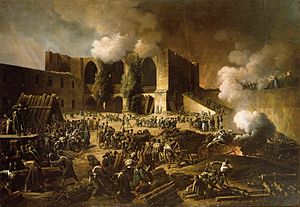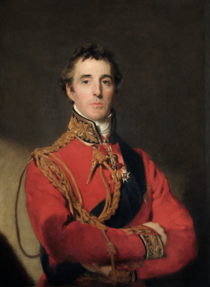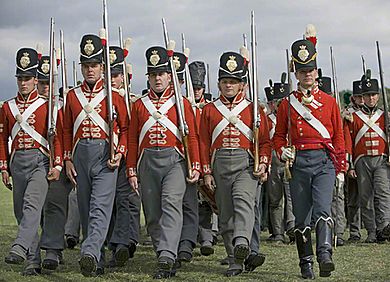Siege of Burgos facts for kids
Quick facts for kids Siege of Burgos |
|||||||
|---|---|---|---|---|---|---|---|
| Part of the Peninsular War | |||||||
 The Siege of Burgos, by François Joseph Heim |
|||||||
|
|||||||
| Belligerents | |||||||
| Commanders and leaders | |||||||
| Strength | |||||||
| 2,000 | 32,000-35,013 8 guns |
||||||
| Casualties and losses | |||||||
| 200-304 killed 323-450 wounded 60 captured 7 guns lost |
550 killed 1,550 wounded 3 guns lost |
||||||
The Siege of Burgos was a battle that took place from September 19 to October 21, 1812. It was part of the Peninsular War, which was a big conflict during the Napoleonic Wars. In this battle, the Anglo-Portuguese Army, led by General Arthur Wellesley, tried to capture the castle of Burgos in Spain.
The castle was defended by a French army led by General Jean-Louis Dubreton. The French soldiers were very good at defending their fort. They stopped every attack by Wellington's army. Because of this, Wellington had to give up and retreat. Burgos is a city located about 210 kilometers (130 miles) north of Madrid.
Before this siege, Wellington had won a big victory at the Battle of Salamanca in July 1812. This win allowed him to move his army towards Madrid. The French King Joseph Bonaparte and his general, Marshal Jean-Baptiste Jourdan, had to leave Madrid. They went to Valencia to join other French forces.
Wellington hoped to quickly capture Burgos. It was an important French supply base. But General Dubreton led a very strong defense. He stopped Wellington's attacks many times. Wellington's plans to stop the French from fighting back failed. Large French armies started to move towards Burgos and Madrid. Because of this, Wellington had to retreat. He left many areas of Spain that his army had just freed.
Contents
Why the Siege Happened
Wellington's victory at the Battle of Salamanca on July 22, 1812, made the French army in Spain much weaker. After the battle, King Joseph Bonaparte and his troops moved towards Madrid. Wellington's army reached Valladolid on July 30. He left some troops to watch the French and then moved towards Madrid with 36,000 soldiers.
On August 11, there was a small fight near Madrid. French cavalry fought with Allied (British and Portuguese) cavalry. The French were eventually stopped by more Allied soldiers.
King Joseph left Madrid, and Wellington's army entered the city on August 12. The people of Madrid were very happy. The next day, Wellington's army attacked the Retiro forts in Madrid. The forts surrendered quickly. Wellington's army captured many French soldiers and a lot of supplies.
King Joseph's soldiers retreated to Valencia on the east coast. Wellington knew that if the French armies joined together, his position in central Spain would be in danger. He hoped that capturing Burgos would slow down any French attacks from the north.
However, the French army in the north, led by General Clausel, quickly got stronger. On August 13, Clausel marched towards Valladolid with 25,000 troops. Wellington had to go after him. Clausel managed to escape, but he left 2,000 soldiers to defend Burgos. Wellington then left General Rowland Hill to defend Madrid. Wellington's best fighting groups were with Hill.
Attacking the Fort
Wellington's army, with about 35,000 British, Portuguese, and Spanish soldiers, began the siege of Burgos castle on September 19. The French defenders had about 2,000 soldiers. They were led by General Jean-Louis Dubreton. The castle had strong defenses, including a part called the Napoleon Battery.
Wellington did not have many heavy cannons for the siege. He had only a few large guns. He also didn't want to attack with a huge number of soldiers because of heavy losses in earlier sieges. The British army also didn't have many engineers (called Military Artificers back then) who were skilled at building siege works.
The San Miguel Hornwork
Wellington ordered an attack on the San Miguel hornwork on the night of September 19. A hornwork is a type of outer defense for a fort. This attack happened without any cannon support. The British soldiers were seen by the French in the moonlight. More than 200 men were killed. Another 100 Portuguese soldiers were also lost.
However, some British soldiers managed to get behind the hornwork. The French defenders then ran away, and the Allies took control of the hornwork. The French lost 138 killed or wounded, and 60 men were captured. The Allies lost 421 soldiers killed or wounded.
Inside Burgos Castle
After taking the hornwork, British engineers started digging trenches and setting up cannons. On September 22, Wellington ordered another attack before his cannons had even fired. Soldiers from the 1st and 6th British Divisions rushed forward. They tried to break through the defenses with axes and ladders. But they were easily pushed back. About 150 of the 400 attackers were killed or wounded.
The engineers then started digging a tunnel, or "mine," under the fort's west wall. When it exploded on September 29, part of the wall fell down. But the main French defenses were not damaged. This was because the mine was under an older, buried wall.
Wellington was frustrated and ordered a new mine to be dug. His soldiers also worked at night to set up a new cannon battery close to the walls. But on October 1, the French found this position. They quickly used their cannons to destroy two of the three British guns. They also caused many losses among the gun crews. The British tried to rebuild the battery, but it was destroyed again.
When the new mine was ready on October 4, it exploded. It blew a 100-foot hole in the northwest wall. Many French defenders in that area were killed. The British attacked again and managed to get a small hold in the outer defenses. But they lost 220 more soldiers.
General Dubreton then launched a surprise attack from the fort on October 5. The French killed or wounded almost 150 Allied soldiers. They also took or ruined much of their equipment. Dubreton attacked again on October 8, causing 184 more Allied losses.
Heavy rain started to fall, filling the trenches with water. The British cannons ran low on ammunition. They even started reusing French cannonballs. Wellington wrote that it was the "most difficult job" he had ever faced with so few resources.
A third mine was dug. On October 18, it exploded near the south wall. Attacks were made on the west and north walls. But these attacks were not well supported. They failed because of strong French fire. Another 170 Allied soldiers were lost.
With a large French army coming to help Burgos, and with his own army running out of cannons and ammunition, Wellington decided to retreat. He began to pull his army back on October 21. He could not even take all his siege cannons with him. The British lost 550 killed and 1,550 wounded during the siege. The French lost 304 killed and 323 wounded.
What Happened Next
While Wellington was at Burgos, other French armies were moving. Marshal Soult had left the siege of Cadiz and joined forces with King Joseph. By October 15, Joseph's army, with 61,000 soldiers, was moving towards Madrid. In the north, General Joseph Souham's army grew to 53,000 soldiers.
Wellington had about 73,000 troops in total. But they were spread out. He had 24,000 at Burgos and 11,000 Spanish soldiers. General Hill was defending Toledo with 20,000 soldiers. Another 18,000 were in Madrid. Wellington was far from Hill's army. The river that was supposed to protect his southern side was too low.
Wellington realized he was greatly outnumbered by the French. He felt lucky that they did not attack him directly. He knew his army could have been destroyed. Still, he did not want to retreat.
Retreat from Burgos
Wellington ended the siege of Burgos on October 21. He left quietly, and the French did not realize he was gone until October 22. There was a small battle on October 23. The Allied army then moved back behind the Pisuerga River.
Between October 25 and 29, Souham and Wellington fought several battles along the Pisuerga and Carrión Rivers. These battles are known as the Battle of Tordesillas. When the French captured a bridge over the Duero River on October 29, Wellington had to order a full retreat.
Leaving Madrid
On October 29, General Hill received orders from Wellington to leave Madrid. Hill's army fought a small battle with the French on October 30. Then, Hill broke away and moved to join Wellington. King Joseph re-entered Madrid on November 2. He quickly went after the British, not leaving any soldiers to guard Madrid.
Wellington and Hill's armies finally joined together on November 8. On November 15, Soult's 80,000 French soldiers faced Wellington's 65,000 Allied soldiers near the old Salamanca battlefield. But Soult decided not to attack. Wellington then began to retreat further west.
The Difficult Retreat
The retreat was very hard for Wellington's army. They marched in cold, pouring rain for four days. They had very little food. The French cavalry followed them closely. They captured hundreds of Allied soldiers who had fallen behind. On November 16, 600 Allied soldiers were captured. Even more were captured on November 17, including Wellington's second-in-command.
Before reaching the safe fortress of Ciudad Rodrigo, the Allied armies lost about 5,000 men. Most of these soldiers died from hunger or from being exposed to the cold during the chaotic retreat. It seemed like all of Wellington's hard work in 1812 had been for nothing. However, his army had gained a strong confidence over the French that they would keep.
Images for kids
See also
 In Spanish: Asedio del Castillo de Burgos (1812) para niños
In Spanish: Asedio del Castillo de Burgos (1812) para niños





